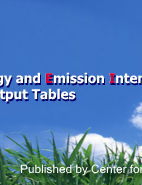![[3EID] Embodied Energy and Emission Intensity Data for Japan Using Input-Output Tables](../img/img_top1.jpg)





The acronym 3EID represents the title of a data book: Embodied Energy and Emission Intensity Data for Japan Using Input-Output Tables, published in 2002. It contains sectoral embodied environmental burden intensities calculated using Japanese input-output tables. The web edition of 3EID provides updated data related to embodied intensities.
The embodied environmental burden intensities of 3EID represent the environmental burdens (energy consumption and emissions) generated directly and indirectly by the unit production activity (equivalent to one million yen) of a sector. We derived these embodied intensities using an environmental input-output analysis with Japanese input-output tables, which consist of about 400 commodity sectors. They are among the most prominent input-output tables with high sector resolution in the world. The tables define economic relationships among sectors by matrix representation based on annual transactions among sectors.
As in Japan, embodied environmental burden intensities using input-output tables have been developed in the USA, several European countries, South Korea, and Australia. They have been used broadly in the field of environmental system analysis, e.g., for structural analyses of linkage between the economy and the environment, carbon footprint calculation, life cycle assessment (LCA), evaluation of eco-efficiency, industrial ecology, and sustainable consumption and production.
The National Institute for Environmental Studies (NIES) in Japan started to supply a data book including embodied CO2 emission intensity data in 1997: "Carbon dioxide emission intensity based on Input-Output Analysis." Then, in 2002, NIES published 3EID, which included embodied intensities of energy consumption and air pollutant emissions as well as those of CO2 emission. The web edition of 3EID was launched in 2003.
To support users' understanding of the calculation process of the embodied environmental burden intensities, 3EID provides a detailed description of how values were estimated. Furthermore, it includes data used for calculations such as those for sectoral fuel consumption and pollutant emission factors. These supplemental materials enable users to use 3EID for an original framework such as hybrid-LCA combining an input-output table and process data, and enable users to confirm values related to 3EID compilation.
We hope that 3EID will contribute to solving 3E issues of Energy, Environment, and Economy through its use as a practical InDicator.
